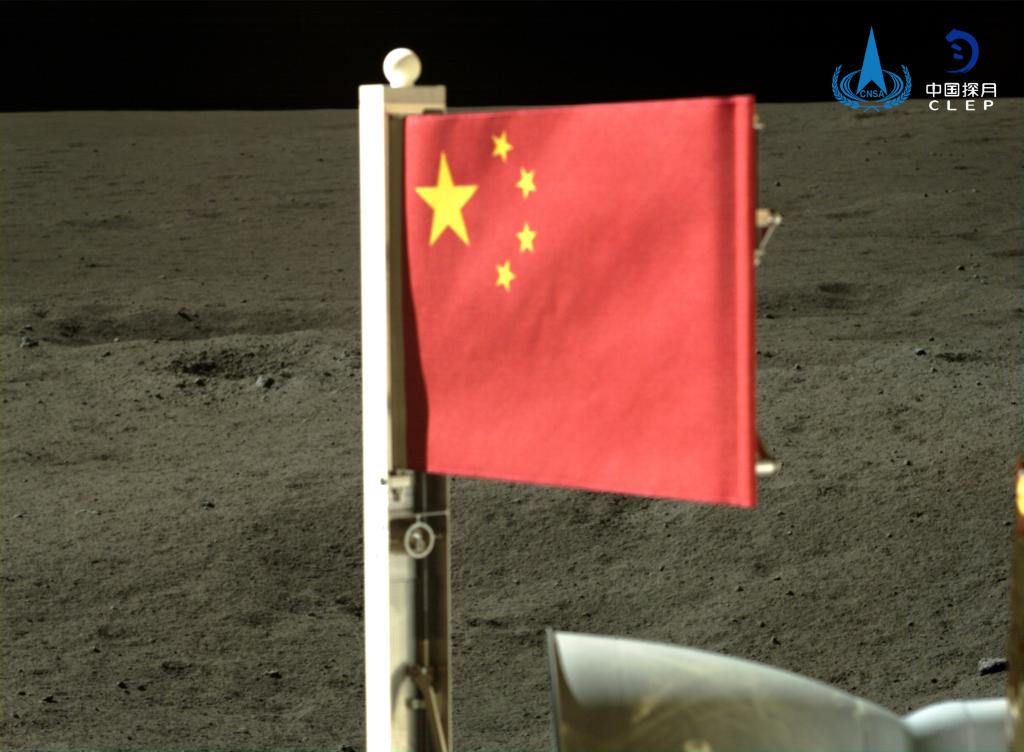


A Chinese national flag carried by the lander of Chang'e-6 probe unfurls at the moon's far side, June 4, 2024.(CNSA/Handout via Xinhua)
by Xinhua writers Liu Yiwei, Yu Fei, Quan Xiaoshu
BEIJING, June 6 (Xinhua) -- While collecting lunar samples on the far side of the moon, China's Chang'e-6 mission thrilled the nation with a photo of the bright red Chinese national flag unfurled on the desolate lunar surface.
Even more interestingly, one of the flag's raw materials is basalt, which piqued the curiosity of netizens and sparked lively discussions on social media.
"Unbelievable! I thought making a national flag out of stone was something you'd only see in sci-fi novels," commented a user on China's popular social media Sina Weibo.
The China Aerospace Science and Industry Corporation (CASIC), the main developer of the national flag display system, explained that during the journey to the moon, the Chang'e-6 probe faced intense radiation and extreme temperature fluctuations, making ordinary materials unsuitable for the lunar flag.
Basalt fiber boasts exceptional insulation and radiation resistance, making it ideal for withstanding the harsh conditions on the lunar surface. However, as an inorganic fiber, it is smooth and brittle, which makes it difficult to spin and maintain in high-durability colors, according to the CASIC.
The team of researchers from CASIC overcame many technical challenges to develop the national flag with superior corrosion resistance, high-temperature tolerance and low-temperature endurance by utilizing technologies such as basalt melting and drawing.
The basalt rocks came from Yuxian County in north China's Hebei Province. The team pulverized and melted the basalt rocks, then drew them into ultra-fine fibers roughly one-third the diameter of a human hair, before spinning them into threads and weaving the threads into fabrics, said Zhou Changyi, a designer of the Chang'e-6 probe.
The flag measures 300 mm by 200 mm, roughly the size of an A4 sheet of paper, and weighs only 11.3 grams, which is 0.5 grams lighter than the one carried by the Chang'e-5 mission to the near side of the moon in 2020.
The abundant basalt on the moon's surface could potentially be used to make fibers and construction materials for establishing a lunar base in the future, Zhou said.
The team also took measures to ensure the best imaging effect of the national flag.
"Lighting is crucial for the imaging effect," said Wang Bozhe, who works with the CASIC and is the technical leader of the Chang'e-6 national flag display system.
Given that Chang'e-6 touched down on the far side of the moon, where the lighting and angle of the flag surface differ from those of Chang'e-5, the team conducted multiple rounds of plan assessments and ground-based simulation tests to replicate lunar surface imaging conditions.
The team also evaluated and verified the lifespan of the national flag display system, ensuring its reliable operation on the far side of the moon.
点击右上角![]() 微信好友
微信好友
 朋友圈
朋友圈

请使用浏览器分享功能进行分享
